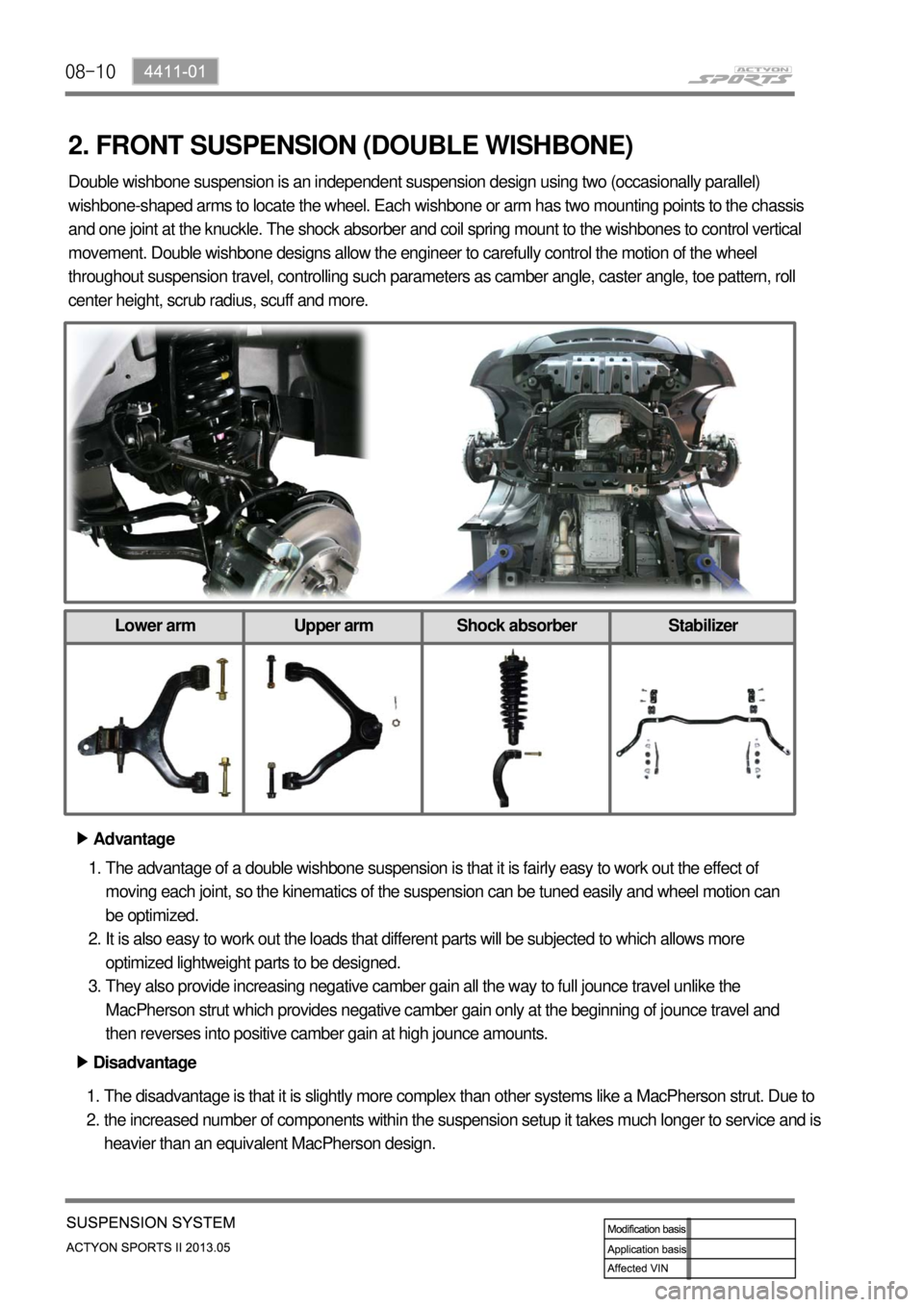Page 540 of 751
08-34411-01
1. SPECIFICATIONS
2. WHEEL ALIGNMENT
Description Specification
Front SuspensionSuspension typeDouble wishbone
Spring typeCoil spring
Shock absorber typeReciprocating cylindrical type (gas type)
Stabilizer bar typeTorsion bar type
Rear SuspensionSuspension type5-link type
Spring typeCoil spring
Shock absorber typeReciprocating cylindrical type (gas type)
Stabilizer bar typeTorsion bar type
Front
Wheel
AlignmentTOEUnilateral : 0.10 ± 0.16°
Total : 0.20 ± 0.13°
Camber-0.5 ± 0.25°
Caster4.6 ± 0.4°
Page 541 of 751
08-4
3. SYSTEM LAYOUT AND TIGHTENING TORQUE OF
FRONT SUSPENSION
Upper arm assembly
Coil spring
Shock absorber
Front axle shaft assembly
Steering gear
box assembly Lower arm assembly
Shock absorber yoke
Knuckle assembly
Stabilizer bar assembly
Front View ▶
Upper arm (on knuckle) nut
Tightening torque: 140 ~ 160 Nm
Lower arm (on knuckle) nut
Tightening torque: 140 ~ 160 Nm
Shock absorber (to yoke) bolt
Tightening torque: 125 ~ 145 Nm
Page 543 of 751
08-6
4. SYSTEM LAYOUT AND TIGHTENING TORQUE OF REAR
SUSPENSION
Lower arm (link)
Stabilizer bar link
Stabilizer bar
Shock absorber
Coil spring seat (upper side)Lateral rod
Axle housing Upper arm (link)Top View ▶
Page 546 of 751
08-94411-01
Under View (4WD, Automatic Transmission)
Rear suspension
1. SUSPENSION
The suspension is the device to connect the axle and vehicle. It absorbs the vibrations and impacts from
road surface, which enhances the comforts, driving force, braking force and drivability.
Front suspension
Page 547 of 751

08-10
2. FRONT SUSPENSION (DOUBLE WISHBONE)
Advantage ▶
The advantage of a double wishbone suspension is that it is fairly easy to work out the effect of
moving each joint, so the kinematics of the suspension can be tuned easily and wheel motion can
be optimized.
It is also easy to work out the loads that different parts will be subjected to which allows more
optimized lightweight parts to be designed.
They also provide increasing negative camber gain all the way to full jounce travel unlike the
MacPherson strut which provides negative camber gain only at the beginning of jounce travel and
then reverses into positive camber gain at high jounce amounts. 1.
2.
3.
Disadvantage ▶
The disadvantage is that it is slightly more complex than other systems like a MacPherson strut. Due to
the increased number of components within the suspension setup it takes much longer to service and is
heavier than an equivalent MacPherson design. 1.
2. Double wishbone suspension is an independent suspension design using two (occasionally parallel)
wishbone-shaped arms to locate the wheel. Each wishbone or arm has two mounting points to the chassis
and one joint at the knuckle. The shock absorber and coil spring mount to the wishbones to control vertical
movement. Double wishbone designs allow the engineer to carefully control the motion of the wheel
throughout suspension travel, controlling such parameters as camber angle, caster angle, toe pattern, roll
center height, scrub radius, scuff and more.
Lower arm Upper arm Shock absorber Stabilizer
Page 548 of 751
08-114411-01
3. REAR SUSPENSION (MULTI LINK TYPE)
Multi-link (5-Link) type suspension is the independent suspension. It provides good ride comfort and
drivability by reducing the coil spring weight. Also, it increases the space for passenger compartment by
lowering the floor. This type of suspension consists of multiple links such as coil spring, shock absorber,
upper and lower arms, lateral rod and stabilizer bar.
Shock absorber Stabilizer bar Rear coil spring
Lower arm Upper arm Lateral rod
Page 556 of 751

09-74850-01
Problem Possible Cause Action
Noise or vehicle
vibration when appliedIncorrectly mounted back plate or caliper Repair
Loosened bolt of back plate or caliper Retighten
Uneven wear of brake disc Replace
Brake pad contamination Clean or replace
Sticking brake pad on contact surface Replace
Wear or hardening of brake pad Replace
Excessive clearance between caliper and pad Repair
Uneven contact of pad Repair
Lack of lubrication in sliding parts Lubricate
Improper operation of caliper Replace
Dust cover missing Repair
Loosened suspension mounting bolt Retighten
Pulls to one side when
brakingUnbalanced tire pressure between left and right Adjust
Poor contact of brake pad Repair
Oil or grease on brake pad Replace
Scratch, uneven wear, distortion of brake disc Replace
Improperly installed brake caliper Repair
Improper operation of auto adjuster Repair
Crack or distortion of brake pad Replace
Poor braking Oil leak or contamination Repair or replace
Air in brake line Bleed air
Improper operation of brake booster Repair
Poor contact of brake pad Repair
Oil or grease on brake pad Replace
Improper operation of auto adjuster Repair
Clogged brake line Repair
Improper operation of proportioning valve Repair
3. TROUBLESHOOTING
Page 642 of 751

12-134610-01
4. TROUBLESHOOTING
Problem Possible Cause Action
Movements of steering
feels heavyIrregular wear or binding of steering ball joint due
to lack of lubrication or foreign material insertionLubricate or replace
Damaged or defective steering gear Replace the steering
gear assembly
Incorrect steering pinion preload Adjust
Defective steering shaft joint Replace
leakage of steering fluid Repair or replace
Insufficient steering fluid or air insertion Fill up fluid or bleed air
Defective steering oil pump Replace
Damaged or loosened pump drive belt Adjust or replace
Clogging of fluid line Repair or replace
Damaged wheel or tire Repair or replace
Defective suspension Repair or replace
Steering wheel pulls to
one sideDamaged steering linkage Replace
Damaged wheel or tire Repair or replace
Defective suspension Repair or replace
Defective brake system Repair or replace
Excessive free play of
steering wheelWorn steering gear Replace the steering
gear assembly
Worn or damaged steering ball joint Replace
Looseness of steering gear box Retighten
Poor returning of
steering wheelBroken or binding of steering ball joint Replace
Improper correct steering pinion preload Replace the steering
gear assembly
Damaged wheel or tire Repair or replace
Defective suspension Repair or replace